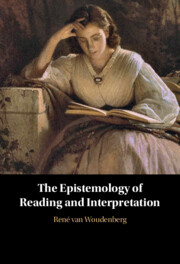36 results
Chapter 2 - Reading and Understanding
-
- Book:
- The Epistemology of Reading and Interpretation
- Published online:
- 03 September 2021
- Print publication:
- 16 September 2021, pp 36-56
-
- Chapter
- Export citation
Chapter 4 - Why Reading Doesn’t Reduce Either to Attending to Testimony or to Perception
-
- Book:
- The Epistemology of Reading and Interpretation
- Published online:
- 03 September 2021
- Print publication:
- 16 September 2021, pp 83-110
-
- Chapter
- Export citation
Chapter 6 - The Objects of Reading Are the Products of Writing
-
- Book:
- The Epistemology of Reading and Interpretation
- Published online:
- 03 September 2021
- Print publication:
- 16 September 2021, pp 135-160
-
- Chapter
- Export citation
Chapter 9 - Knowledge through Interpretation (2)
-
- Book:
- The Epistemology of Reading and Interpretation
- Published online:
- 03 September 2021
- Print publication:
- 16 September 2021, pp 208-233
-
- Chapter
- Export citation
Acknowledgments
-
- Book:
- The Epistemology of Reading and Interpretation
- Published online:
- 03 September 2021
- Print publication:
- 16 September 2021, pp vii-viii
-
- Chapter
- Export citation
Copyright page
-
- Book:
- The Epistemology of Reading and Interpretation
- Published online:
- 03 September 2021
- Print publication:
- 16 September 2021, pp iv-iv
-
- Chapter
- Export citation
References
-
- Book:
- The Epistemology of Reading and Interpretation
- Published online:
- 03 September 2021
- Print publication:
- 16 September 2021, pp 234-242
-
- Chapter
- Export citation
Chapter 8 - Knowledge through Interpretation (1)
-
- Book:
- The Epistemology of Reading and Interpretation
- Published online:
- 03 September 2021
- Print publication:
- 16 September 2021, pp 183-207
-
- Chapter
- Export citation
Chapter 3 - Sources of Knowledge and Their Individuation
-
- Book:
- The Epistemology of Reading and Interpretation
- Published online:
- 03 September 2021
- Print publication:
- 16 September 2021, pp 57-82
-
- Chapter
- Export citation
Index
-
- Book:
- The Epistemology of Reading and Interpretation
- Published online:
- 03 September 2021
- Print publication:
- 16 September 2021, pp 243-244
-
- Chapter
- Export citation
Introduction
-
- Book:
- The Epistemology of Reading and Interpretation
- Published online:
- 03 September 2021
- Print publication:
- 16 September 2021, pp 1-14
-
- Chapter
- Export citation
Chapter 1 - Knowing and Reading
-
- Book:
- The Epistemology of Reading and Interpretation
- Published online:
- 03 September 2021
- Print publication:
- 16 September 2021, pp 15-35
-
- Chapter
- Export citation
Chapter 7 - Texts, Meanings, and Interpretation
-
- Book:
- The Epistemology of Reading and Interpretation
- Published online:
- 03 September 2021
- Print publication:
- 16 September 2021, pp 161-182
-
- Chapter
- Export citation
Contents
-
- Book:
- The Epistemology of Reading and Interpretation
- Published online:
- 03 September 2021
- Print publication:
- 16 September 2021, pp v-vi
-
- Chapter
- Export citation
Chapter 5 - Reading as a Source of Knowledge
-
- Book:
- The Epistemology of Reading and Interpretation
- Published online:
- 03 September 2021
- Print publication:
- 16 September 2021, pp 111-134
-
- Chapter
- Export citation

The Epistemology of Reading and Interpretation
-
- Published online:
- 03 September 2021
- Print publication:
- 16 September 2021
7 - The Delineation of Common Sense
- from Part II
-
-
- Book:
- The Cambridge Companion to Common-Sense Philosophy
- Published online:
- 06 November 2020
- Print publication:
- 19 November 2020, pp 161-184
-
- Chapter
- Export citation
Introduction: Why Common Sense Matters
-
-
- Book:
- The Cambridge Companion to Common-Sense Philosophy
- Published online:
- 06 November 2020
- Print publication:
- 19 November 2020, pp 1-16
-
- Chapter
- Export citation
Part I
-
- Book:
- The Cambridge Companion to Common-Sense Philosophy
- Published online:
- 06 November 2020
- Print publication:
- 19 November 2020, pp 17-158
-
- Chapter
- Export citation
Contents
-
- Book:
- The Cambridge Companion to Common-Sense Philosophy
- Published online:
- 06 November 2020
- Print publication:
- 19 November 2020, pp v-vi
-
- Chapter
- Export citation



